Cyrano3 to its equivalent MFront
implementationPLEIADES platformCast3M finite element
solverNumerous performance assessments were made within the PLEIADES
platform : replacing fortran implementations by their
MFront counterparts led to significant improvements, from
\(30\%\) to \(50\%\) of the total computational times of
some fuel performance codes developed in the platform.
These improvements were mainly due to fact that the behaviour
integration schemes changed from explicit Runge-Kutta schemes to
implicit ones. The main benefit of MFront was to grant
users an easier access to the implicit schemes.
Cyrano3 fuel
performance codeRelying on the specific modelling hypotheses supported by this code,
namely axisymmetrical generalised plane stress and axisymmetrical
generalised plane strain, highly specialised and efficient
implementations of mechanical behaviours were developed in
Cyrano3 fuel performance code [see 1] for both isotropic and
orthotropic materials : numerical integration boils down to solving a
scalar non-linear equation in both cases and provides the consistent
tangent operator.
The figure below compares the total computational times of a native
implementation of a cladding behaviour to its equivalent
MFront implementation: the last one appears to be
competitive with the native implementation (the average computational
time using the MFront implementation is sightly lower than
the average computational time using the native implementation).
Code-Aster finite element solver| Behaviour and test description | Algorithm | Total computational times
(Code-Aster vs MFront) |
Graphical illustration |
|---|---|---|---|
| Visco-plastic and damaging for steel [see 2, 3] - 3D Notched specimen implying large deformation | Implicit |
\(17mn 43s\) vs \(7mn 58s\) | 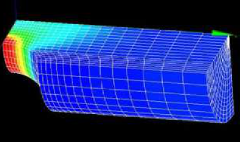 |
| Damaging for concrete [see 4, 5], 3D beam bending | Default |
\(45mn\) vs \(63mn\) | 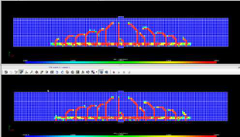 |
| Generic Single crystal viscoplasticity [see 6, 7], 3D aggregate, 300 grains | Implicit |
\(28mn\) vs \(24mn\) | 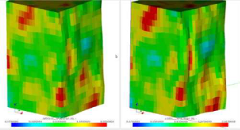 |
| FCC single crystal viscoplasticity [7] , 2D specimen with displacement boundary conditions from EBSD experiment | Ìmplicit |
\(33m54s\) vs \(29m30s\) | 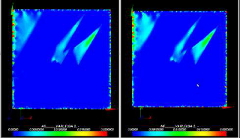 |
| FCC homogenized polycrystals 30 grains [7, see 9], unit testing | Runge-Kutta 4/5 |
\(9s67\) vs \(8s22\) | 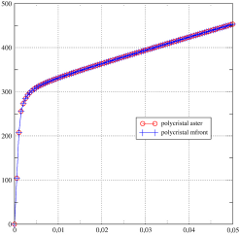 |
| Anisotropic creep with phase transformation, 3D pipe [see 10] | Implicit |
\(180s\) vs \(171s\) | 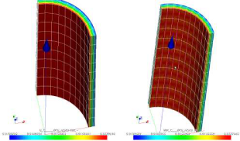 |
Developers of the Code-Aster general purpose finite
element solver, made independent extensive tests, comparing their own
native implementations to the ones generated with MFront,
generally using an implicit scheme in both cases. Without discussing the
very details of each test performed, several general conclusions can be
drawn:
MFront
behaviours. In the second case, the difference can be explained by the
fact that the Code-Aster implementations uses the Brent algorithm [see 12]
which clearly outperforms the standard Newton method. The availability
of this algorithm in MFront is planned.MFront implementation is
on par or outperforms the native implementations.For a given behaviour, the development time was found significantly
lower with MFront.